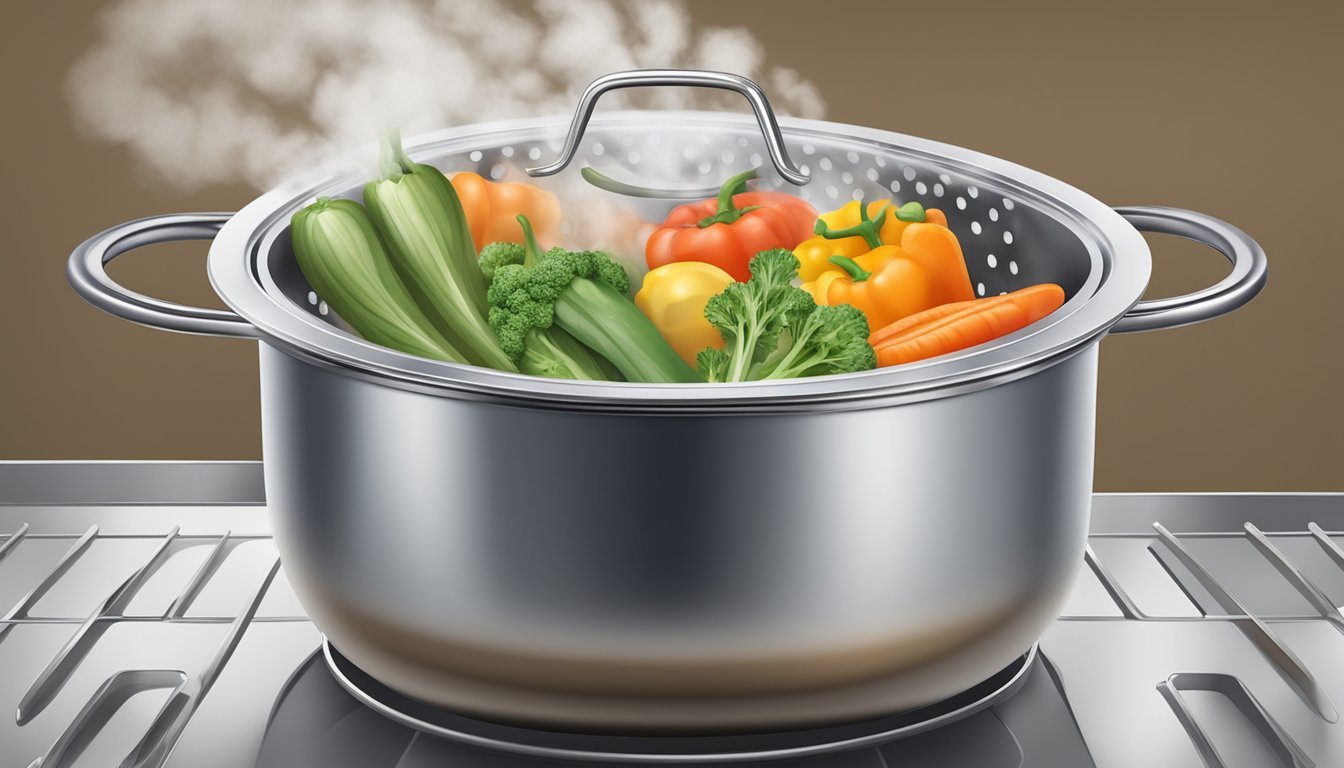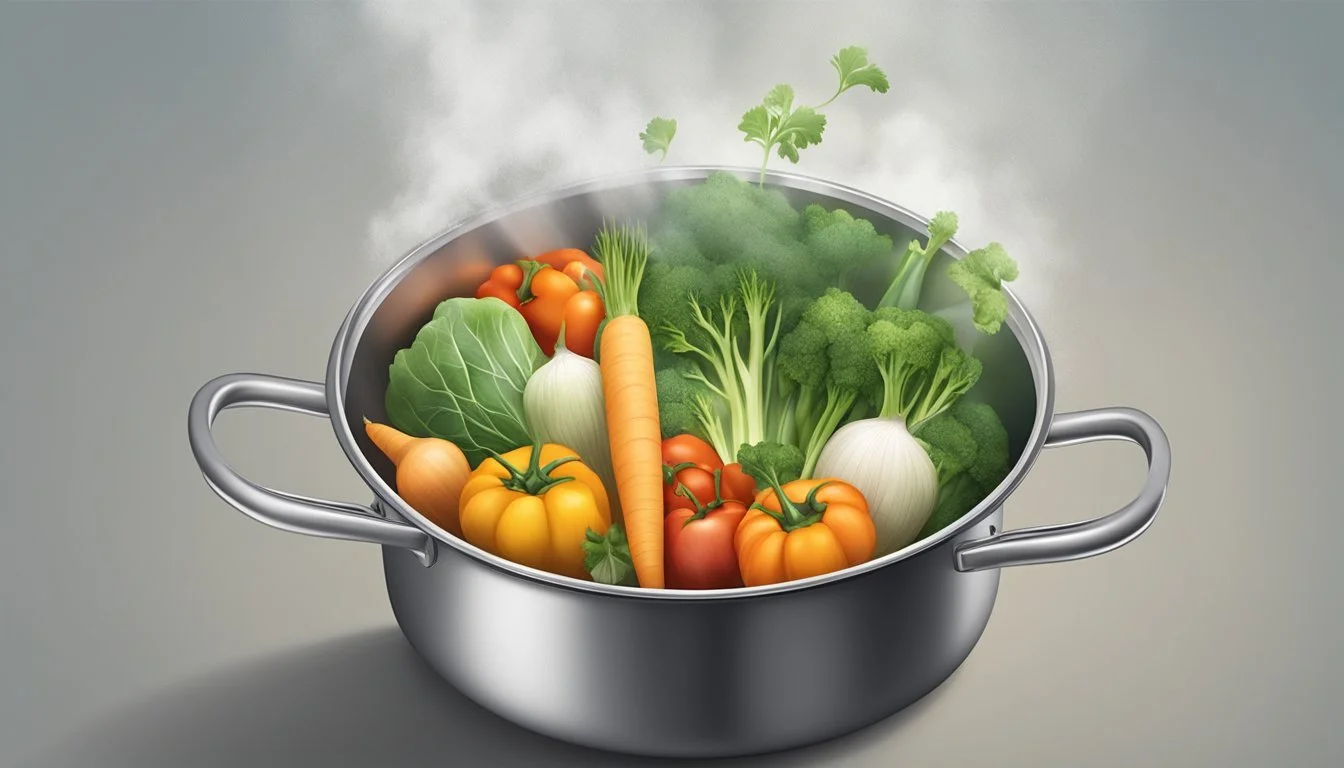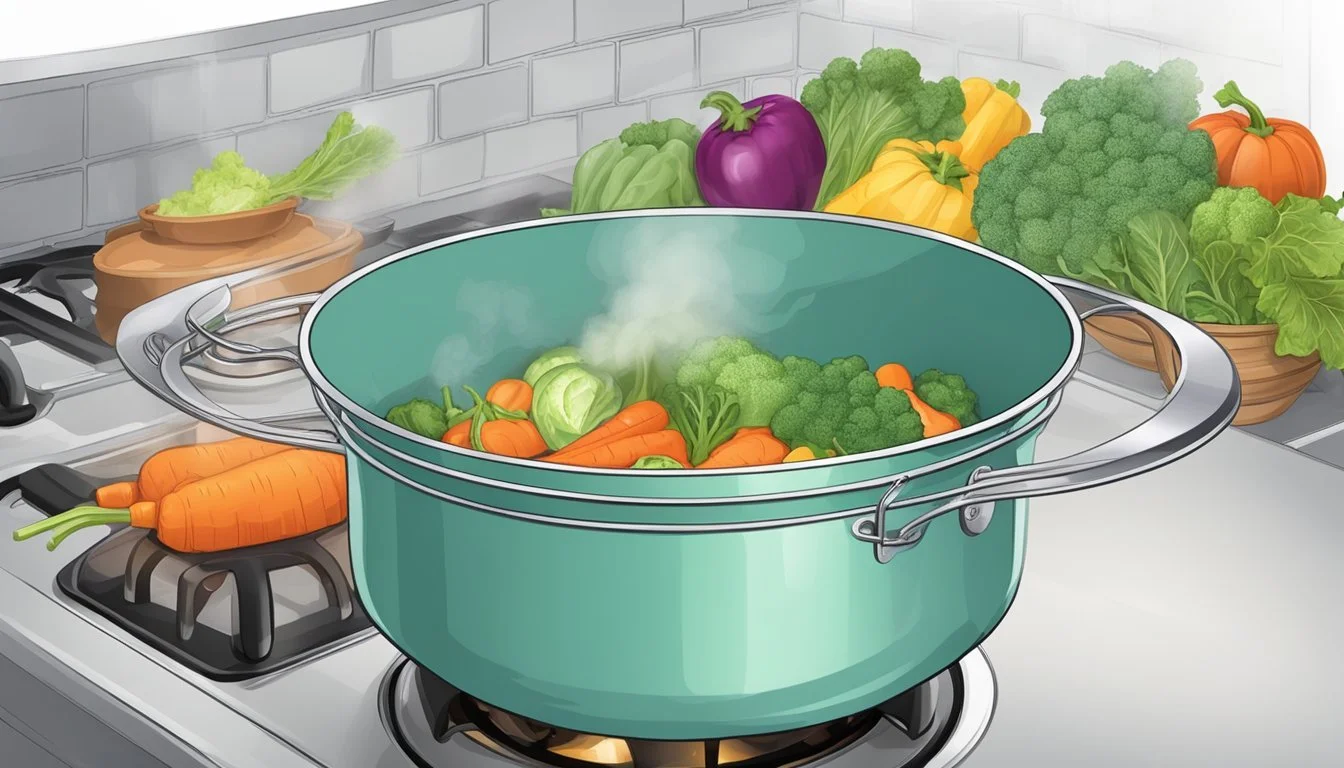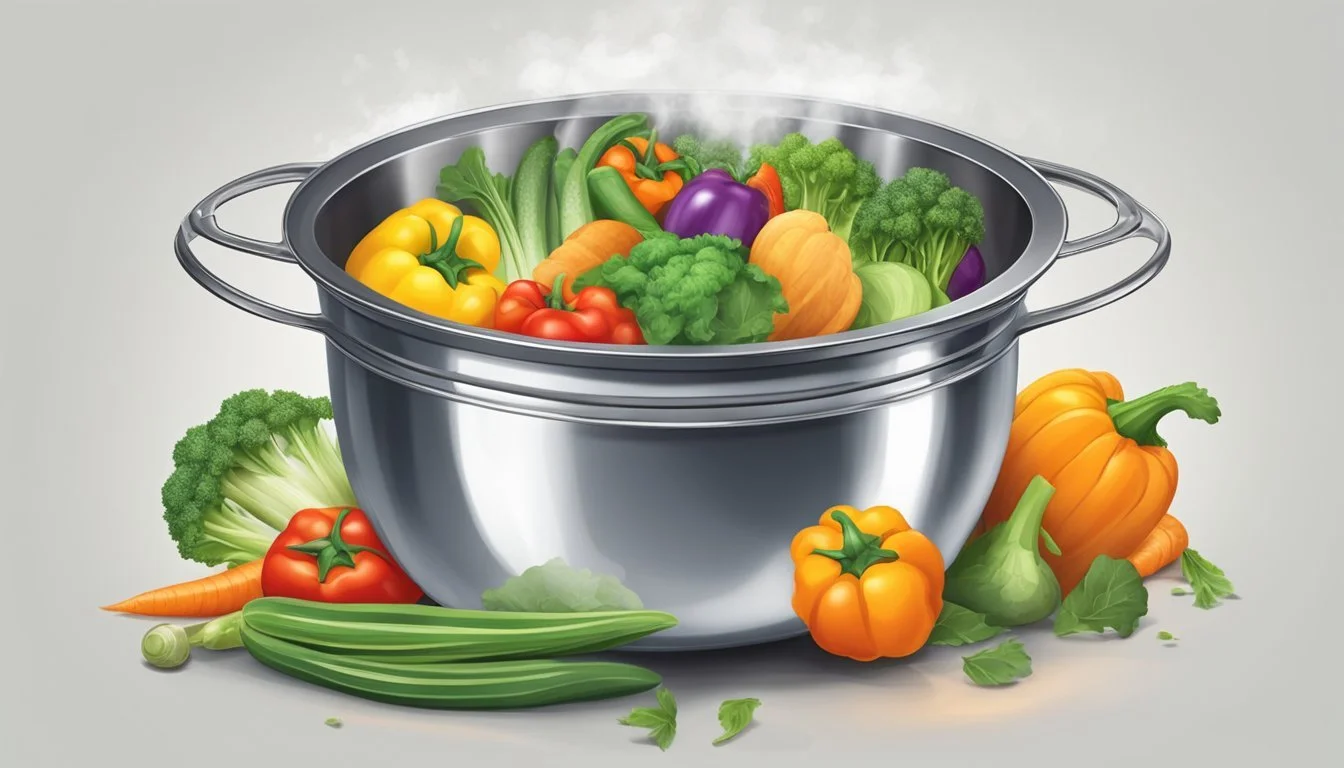The DIY Vegetable Steamer
Simple Steps to Steam with a Colander and Pot Lid
Steaming vegetables is a cooking method cherished for preserving nutrients and creating a delicate texture. However, not every kitchen is equipped with a specialized steamer basket. Home cooks can circumvent this minor obstacle with an innovative approach that utilizes common kitchen equipment. A colander and pot lid, staples in most households, can be effectively transformed into a makeshift vegetable steamer, enabling the steaming process without the need for specific gadgets.
This makeshift steaming technique involves using a colander that fits snugly into a pot without touching the simmering water at the bottom. By placing the colander above the water, it acts as a platform for the vegetables. Covering the pot with a lid then traps steam, which circulates to cook the vegetables gently and evenly. This method not only saves on kitchen space by avoiding additional equipment but also retains the flavors and nutritional content of the food better than many other cooking methods.
Basics of Steaming
In the quest for healthy cooking, steaming stands out as a method that preserves nutrients and natural flavors. This section examines the foundational principles of this technique and the advantages it presents, particularly for vegetables.
Understanding Steaming
Steaming is a cooking method that involves using the heat from vaporized water to cook food. A steamer typically consists of a vessel for boiling water to produce steam and a basket or insert that holds the food suspended above the water. Heat causes water to turn into steam, which then circulates within the pot, transferring heat to the food without direct contact with the water. This allows vegetables to cook evenly and retain much of their natural texture and color.
Key components for successful steaming include:
Consistent Heat: Ensure the pot maintains a steady boil to keep the steam constant.
Time Management: Vegetables require careful timing since over-steaming can lead to mushy textures.
Lid: A tight-fitting lid is essential to trap steam effectively within the pot.
Benefits of Steaming Vegetables
Steaming vegetables offers numerous health benefits. The gentle cooking process reduces nutrient leaching, helping vegetables to maintain higher levels of vitamins and minerals than other cooking methods, such as boiling. Since steaming doesn't require oils or fats, it can result in lower calorie dishes, aligning with a healthy dietary regimen.
Furthermore, steaming respects the integrity of the vegetable, preserving its natural flavors and colors, leading to more appealing and tasteful dishes. This makes it an excellent choice for those who appreciate the authentic taste of vegetables.
Nutrient Retention: Vegetables keep a higher nutrient profile when steamed as opposed to other cooking methods.
Calorie Control: Steaming requires no additional fats, contributing to lower-calorie meals.
Flavor Preservation: Vegetables maintain their natural flavor, eliminating the need for excessive seasoning.
By utilizing a colander and pot lid for a DIY steamer, one can employ this effective cooking method to reap the benefits of nutrient-rich and naturally flavored vegetables.
Setting Up Your DIY Steamer
Creating a steamer for vegetables in the absence of a specialized steamer basket can be simply achieved with common kitchen items. This setup involves using a colander and a pot lid, ensuring that deliciously steamed vegetables are just a few steps away.
Choosing the Right Equipment
Selecting the appropriate pot is the first step; it should be large enough to hold the colander without the bottom of the colander touching the base of the pot. A large pot with a lid is ideal, as it allows for sufficient steam build-up, which is crucial for the steaming process. The colander used must be metal, as plastic could melt with the heat. It should fit comfortably inside the pot, leaving enough room for a water reservoir beneath.
Creating a Makeshift Steamer Basket
Once the pot and colander have been paired, a makeshift steamer basket can be assembled. Here’s a quick guide:
Fill the pot with approximately 1-2 inches of water, to ensure water will not touch the bottom of the colander, preventing direct contact with the heat and boiling water.
Place the colander inside the pot.
On top of the colander, introduce a heatproof plate or a microwave-safe bowl upside down. This will serve to hold the vegetables above the simmering water.
Cover the pot with its corresponding lid to trap the steam.
Ensure that the lid fits snugly to prevent steam escape, which is essential for even and thorough cooking of the vegetables.
By following these instructions, anyone can successfully steam vegetables using a DIY steamer, crafted from everyday kitchen items without the use of a traditional steamer basket.
Steaming Process
The process of steaming vegetables using a colander and pot lid is both simple and effective. This method harnesses the power of steam to cook veggies while retaining their nutrients and flavor.
Preparing the Pot
To begin, one should choose a suitable pot and fill it with water—about one to two inches deep, ensuring the water level is below the bottom of the colander. It's important to use boiling water to generate sufficient steam. The colander is then placed inside the pot so that it's suspended above the water. The pot should be covered with a tight-fitting lid to trap the steam.
Fill Pot with Water: About 1-2 inches
Insert Colander: Keep above the water level
Cover with Lid: Must be tight-fitting
Arranging the Vegetables
Once the pot is ready, the vegetables need to be prepared for steaming. They should be cut into similar-size pieces to ensure even cooking. The veggies are then arranged in the colander, avoiding overcrowding, to allow steam to circulate around each piece.
Cut Veggies Evenly: Similar-size pieces
Place in Colander: Ensure space between for steam
Heating the prepared pot over the stove will bring the water to a boiling point, and the rising steam will cook the vegetables. One should monitor the pot occasionally to ensure there is always water at the base to produce steam, refilling as necessary while maintaining the desired level.
Cooking Techniques & Tips
When steaming vegetables using a colander, precision in timing and a methodical approach ensure that vegetables are cooked evenly and retain their nutritional value.
Adjusting Steaming Times
Vegetable Size: Smaller pieces steam quicker than larger ones. A consistent cut size promotes even cooking.
Vegetable Type: Different vegetables require varied steaming times. For instance, broccoli may steam in about 3-5 minutes, whereas carrots could take up to 10 minutes.
Desired Texture: Crisp-tender vegetables will need shorter times compared to softer textures.
Consider using a timer to monitor steaming times closely. It may help to create a table with common vegetables and their respective steaming times for reference:
Vegetable Estimated Steaming Time Broccoli 3-5 minutes Carrots 6-10 minutes Green beans 5-7 minutes Cauliflower 5-8 minutes
Ensuring Even Cooking
Heatproof Strainer: Use a sturdy, heatproof colander or strainer that fits well into the pot without touching the water.
Pot Lid: A tight-fitting lid helps to retain steam and promote even cooking. If using a clear lid, one can observe the vegetables without lifting the lid and letting steam escape.
Rotating Vegetables: Halfway through, carefully shuffle the vegetables with tongs for uniform heat exposure.
Steam Flow: Ensure the pot maintains a gentle simmer so that the steam cooks the vegetables without water boiling over.
Steaming vegetables using a colander in place of a traditional bamboo steamer or dedicated steamer basket is an effective cooking method that preserves the vegetables' color, taste, and nutrients. Applying these tips can lead to perfectly steamed vegetables every time.
Versatile Uses of a DIY Steamer
A DIY steamer is not just for vegetables; it's a multipurpose tool that can handle a variety of foods and can be adapted with common kitchen items.
Beyond Vegetables: Steaming Other Foods
One can easily harness the power of steam for cooking a wide range of foods. Steaming ensures gentle cooking that can preserve the nutrients and flavors. Here are specific examples of alternative uses:
Dumplings: Ideal for steaming, as it maintains their delicate wrappers and succulent fillings.
Rice: Achieve fluffy and distinct grains by steaming, rather than boiling.
Fish: Steamed fish retains moisture, making it tender and flavorful.
Chicken: Steaming chicken breasts can result in juicy, lean protein.
Eggs: One can steam eggs to perfection, with a just-set yolk and tender whites.
Alternative DIY Steaming Methods
Not all kitchens have a traditional steamer, but a DIY steamer can be fashioned out of several combinations of kitchen equipment. Here are methods utilizing various kitchen items:
Microwave: Use a microwave-safe dish covered with a lid or microwave-safe plastic wrap. Add a little water at the bottom and microwave until the food is cooked through.
Oven: A roasting pan can double as a steamer. Fill with water, place a heat-resistant colander above, cover with foil, and steam in the oven.
Wok: Perfect for steaming, especially if the DIY steamer is used for Asian-style dumplings. Invert a heat-proof plate over a small amount of water, cover, and use the stove's heat to steam.
Roasting Pan: A deep roasting pan can serve as the base. Cover it with a lid or foil to trap the steam from boiling water.
Selecting Vegetables for Steaming
When choosing vegetables for steaming, it's important to consider their texture and cooking times. The natural flavor and nutrients are best preserved with this gentle cooking method, making it a healthy way to prepare your produce.
Optimal Vegetables for Steaming
Asparagus: Asparagus steams well due to its tender and quick-cooking characteristics. It typically takes 3-5 minutes to become perfectly tender.
Broccoli and Cauliflower: These similar textures make them ideal for steaming, taking approximately 5-7 minutes to cook.
Carrots: Carrots retain their sweet flavor and nutritional content when steamed, usually in about 5-7 minutes depending on cut size.
Green Beans: Green beans maintain a satisfying crunch and vivid color when steamed for just a few minutes.
Spinach and Kale: Leafy greens like spinach and kale wilt down quickly under steam, often in under two minutes, preserving their nutrients and vibrant colors.
Corn on the Cob: Steaming can be a preferred method for smaller cobs, taking around 7-10 minutes.
Potatoes: While larger potatoes might require boiling or baking, small new potatoes can be steamed whole in about 15-20 minutes.
Beans and Peas: Fresh peas and small beans are great for steaming and can take between 2-4 minutes, depending on the variety.
Steaming different vegetables together should be approached with care to ensure even cooking. One could organize vegetables with similar cooking times together to maintain consistency.
Choosing fresh and tender vegetables will yield the best results with steaming. This method offers a way to retain most of the vegetables' nutrients and produce a satisfying texture suitable for various dishes.
Enhancing Flavors
When steaming vegetables, the natural flavors are gently preserved. Yet, it is the savvy use of fats and seasonings that can elevate the taste profile of the steamed produce to new heights.
Using Fats and Seasonings
Olive Oil: A drizzle of olive oil over the steamed vegetables can impart a subtle, fruity undertone that enhances their natural flavor. One can also infuse olive oil with herbs to introduce a more complex flavor palette.
Butter: For a richer taste, a pat of butter can be melted over the hot vegetables post-steaming. The butter's creamy texture pairs well with the tender, moist consistency of the steam-cooked items.
Lemon: A squeeze of fresh lemon juice adds a bright, acidic contrast to the vegetables' earthiness, highlighting their freshness and adding a zesty note that can be quite refreshing.
Seasoning Flavor Profile Pairing Suggestion Olive Oil Fruity, Herbal Leafy Greens, Root Vegetables Butter Creamy, Rich Broccoli, Carrots Lemon Citrusy, Tart Asparagus, Green Beans
Incorporating these fats and seasonings in the steaming process is simple. Season lightly before steaming, then finish with a final touch once the vegetables are cooked to suit individual tastes. This method preserves the integrity of the ingredients while enhancing each vegetable's unique flavor.
Post-Steaming Techniques
Proper post-steaming methods ensure the vegetables maintain their texture and nutritional value after they've been cooked. Transitioning smoothly from steaming to cooling and serving is essential for perfect results.
Cooling and Serving
Cooling: Immersing vegetables in an ice bath post-steaming stops the cooking process immediately, preserving their vibrant color and firmness. This technique, known as "shocking," requires a container filled with ice and water. One should place the steamed vegetables in the ice bath for the same amount of time they were steamed, then drain and serve or incorporate them into a recipe.
For Serving:
Salads: Cool vegetables can be tossed into a garden salad for a refreshing crunch.
Side Dishes: Serve them with a light seasoning or a drizzle of olive oil to complement the main course.
Recipe Incorporation: Chilled vegetables are perfect for stir-fries, pasta or as a vibrant addition to grain bowls.
By utilizing these techniques, one can achieve an appealing texture and temperature, enhancing the dish regardless of whether it's served as a standalone side dish or as part of a larger recipe.
Safety and Maintenance
When using a DIY vegetable steamer, it is crucial to maintain a focus on safety and proper maintenance to ensure longevity of your kitchen tools and prevent any accidents during steaming.
Handling the Steamer Safely
One should always use heatproof gloves when handling the steamer to protect against burns from the steam and hot surfaces. It's important to ensure that the cooking pot is stable on the stove and that the metal colander or baking rack used is stainless steel or another heat-safe material to prevent melting or warping. When placing or removing the colander, the user must keep their face and hands away from the pot to avoid steam burns.
Cleaning and Storing Your DIY Steamer
Post-use, the colander and cooking pot should be washed with warm, soapy water to remove any food residue. Both items should be dried thoroughly before storing to prevent rust formation, especially important for stainless steel items. Store the pot and colander in a dry cabinet, and if using a baking rack as an alternative steaming surface, it should also be cleaned and dried after each use to maintain its condition.










